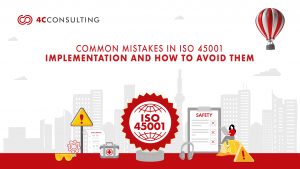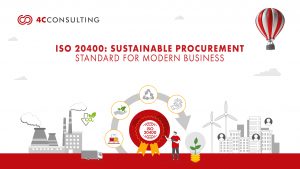HOW ISO 45001 BOOSTS COMPANY REPUTATION & STAKEHOLDER TRUST
28th Aug, 2025Reputation can be lost in a single incident from factory fires to construction accidents, workplace safety failures often dominate headlines, damaging a company’s credibility and shaking stakeholder confidence. Beyond the human cost such events expose organizations to lawsuits, regulatory penalties and loss of market trust consequences that can take years to repair.
This is where ISO 45001 the international standard for Occupational Health and Safety Management Systems (OHSMS) becomes more than a compliance requirement. It provides organizations with a structured framework to protect workers, reduce risks and demonstrate leadership in safety. By achieving ISO 45001 certification, companies signal to employees, regulators, investors, clients and communities that safety is a core business value.
In this blog, we explore how ISO 45001 directly contributes to reputation management and stakeholder trust. With practical examples across industries, you will see why organizations that implementing safety into their culture earn not only compliance certificates but also long-term credibility and competitive advantage.
.
WHAT IS ISO 45001?
ISO 45001 stands for the international standard for Occupational Health and Safety Management Systems (OHSMS). It provides a globally recognized framework to identify hazards, assess risks and improve workplace safety.
The standard shifts organizations from a reactive approach addressing accidents after they happen to a proactive, preventive system that integrating safety into everyday operations. It highlights leadership responsibility, employee participation, compliance with legal requirements and continual improvement.
ISO 45001 applies to organizations of every size and sector from manufacturing and construction to pharmaceuticals, chemicals and services. OHS framework not only reduces incidents but also demonstrates to stakeholders that safety is a core business value and not just a compliance exercise.
.
Build Reputation & Trust with ISO 45001.
.
Stakeholders in ISO 45001
In ISO 45001 stakeholders are referred to as “interested parties” (Clause 4.2). These are individuals or groups both internal and external whose needs and expectations influence the organization’s approach to health and safety. Recognizing and addressing these interested parties is critical because their trust directly impacts the company’s reputation, compliance record and long-term resilience.
| Type of Stakeholder | Examples | Key Expectations |
| Internal Stakeholders | Employees & Workers | Safe working conditions, PPE, training, fair participation in safety decisions |
| Top Management | Strong safety culture, compliance with laws, reduced liabilities, improved reputation |
| Supervisors & Safety Teams | Clear safety policies, tools for hazard identification, authority to enforce controls |
| External Stakeholders | Regulators & Government Bodies | Compliance with occupational health & safety laws, transparent reporting, legal conformity |
| Clients & Customers | Assurance of reliability, certified OHSMS, proof of safety in supply chains |
| Contractors & Suppliers | Clear safety requirements for site access, training, supervision and compliance monitoring |
| Investors & Insurers | Lower risk exposure, reduced claims, strong ESG and sustainability credentials |
| Community & Society | Responsible operations, accident-free environment, community engagement and transparency |
.
How ISO 45001 Boosts Reputation & stakeholder Trust?
ISO 45001 standard establishes a globally recognized framework to identify risks, prevent incidents and create safer workplaces. Instead of treating safety as a reactive obligation the standard enables organizations to integrate health and safety into core operations, decision making and culture. By adopting OHSMS standards, companies demonstrate structured leadership in protecting people, ensuring compliance and sustaining business resilience.
- Public Commitment to Safety: This certification signals that safety is a core value not just a compliance ISO 45001 checklist. This visible commitment reassures stakeholders and proves the organization is ready to be held accountable. It demonstrates leadership maturity, showing that the business prioritizes people before profit.
Example: A construction company displaying ISO 45001 certification in its project bids gained client confidence and improved its chances of securing contracts. - Stronger Compliance with Laws & Regulations: Adhering to ISO 45001 OHSMS requirements ensures ongoing compliance with occupational health and safety laws, minimizing penalties and regulatory oversight. It also demonstrates proactive risk management rather than reactive firefighting. Such consistency reduces reputational risks associated with non-compliance headlines.
Example: A pharmaceutical plant aligned with certification standards avoided fines during a surprise inspection because its legal register and risk assessments were ISO 45001 audit-ready. - Reduction in Accidents & Incidents: By applying a systematic, ISO 45001 risk-based approach it reduces workplace accidents, lowers liabilities and enhances productivity. This leads to fewer compensation claims and minimized downtime. Fewer accidents also signal operational discipline and reliability to external stakeholders
Example: A manufacturing unit recorded a 40% drop in lost-time injuries within one year of ISO 45001 implementation - Improved Employee Trust & Morale: When employees feel safe and valued this fosters loyalty, participation in risk identification, and shared ownership of solutions. A secure workforce becomes an advocate for the company’s credibility
Example: In an automotive plant, worker participation in hazard identification workshops reduced turnover and boosted productivity. - Enhanced Client Confidence: Many global buyers prefer suppliers with ISO 45001 certification as proof of reliability and safe operations. Certified companies are seen as lower risk, ensuring uninterrupted delivery. This confidence often translates into long-term contracts and repeat business.
Example: An Indian engineering firm secured a contract with a European OEM after showcasing its ISO 45001 certification during supplier audits. - Better Insurance & Investor Confidence: With fewer incidents and demonstrable safety performance, companies with ISO 45001 often benefit from reduced insurance premiums and stronger investor trust. Stakeholders see them as sustainable, lower-risk partners. This financial advantage further reinforces market competitiveness.
Example: A chemical company with ISO 45001 certification negotiated reduced insurance premiums due to its strong safety performance record. - Stronger Community Reputation: Safe, responsible operations foster goodwill with local communities and authorities, strengthening the social license to operate. Over time, this resilience supports brand credibility. Community trust acts as a shield during crises or regulatory challenges.
Example: A chemical plant gained positive media coverage by showcasing zero accidents for three consecutive years under ISO 45001. - Resilience in Crisis Situations: Preparedness and emergency response planning under ISO 45001 OHSMS build trust in the company’s ability to manage crises. Stakeholders recognize the organization’s readiness to protect people and assets during emergencies.
Example: During a fire drill at a power plant, ISO 45001 trained staff evacuated 300 workers within minutes, demonstrating efficiency to regulators. - Alignment with ESG & CSR Goals: ISO 45001 directly supports ESG and CSR commitments by proving accountability toward employee well-being and community safety. This enhances sustainability reports and attracts socially conscious investors. It bridges operational safety with corporate responsibility.
Example: A multinational company highlighted its ISO 45001 certification in its annual ESG report, boosting investor confidence & CSR reputation. - Competitive Advantage in Global Supply Chains: In global markets, ISO 45001 certification acts as a qualifier in supplier selection. Certified companies gain access to contracts that uncertified competitors are excluded from. It becomes a passport to enter high-value, safety-driven markets.
Example: A textile exporter won contracts in the EU after proving ISO 45001 compliance, while uncertified competitors were excluded from the tender.
ISO 45001 is more than a compliance certificate it is a trust-building framework. By implementing safety into strategy and culture, organizations not only reduce incidents but also strengthen relationships with employees, clients, regulators, investors and communities. A single certificate becomes a visible proof of accountability, resilience and ethical leadership in these competitive markets. For companies seeking long-term credibility and sustainable growth, ISO 45001 is not just an option but a business initiative it ensures that every stakeholder sees safety as central to your brand identity building confidence, loyalty and competitive advantage in every contract, partnership and market you enter.
.
HOW 4C CONSULTING HELPS YOU IMPLEMENT ISO 45001 CERTIFICATION?
At 4C Consulting, we simplify ISO 45001 implementation and audits by combining 15+ years of expertise, 10,000+ training hours and 50+ workshops into practical, end-to-end support. From conducting gap assessments and aligning your OHSMS policies to preparing audit-ready documentation and mock internal audits, our specialists ensure your team is equipped to answer auditor queries with confidence. Partnering with 4C means fewer surprises during audits, stronger compliance records and a workplace culture where health and safety are truly embedded as a core business value. Book your free ISO 45001 Gap analysis today.

Frequently Asked Questions:
ISO 45001 is not legally mandatory, but regulators, global buyers and supply chains increasingly demand certified OHSMS. For high-risk industries like construction, pharma and manufacturing, certification proves compliance, minimizes risks and reduces regulatory scrutiny.
By integrating occupational health and safety into everyday operations, ISO 45001 demonstrates accountability to employees, clients and regulators. A certified OHSMS reduces accidents, ensures compliance and builds stakeholder confidence while enhancing long-term brand reputation.
OHSAS 18001 was replaced by ISO 45001, which follows Annex SL, emphasizes leadership involvement, risk-based thinking and worker participation. Unlike OHSAS, ISO 45001 aligns with other ISO standards, making it globally recognized and future-ready.
The certification timeline depends on size, scope and system maturity. SMEs may achieve it in less time months, while larger multi-site companies may take longer time, covering gap analysis, documentation, training, audits and certification.
Manufacturing, construction, oil & gas, logistics, pharma and chemical industries benefit the most due to high risk levels. However, service organizations and SMEs also adopt ISO 45001 to win contracts, improve safety culture and boost global credibility.
Core ISO 45001 requirements include hazard identification, risk assessment, legal compliance, safety objectives, emergency preparedness and continual improvement. Leadership commitment and active worker participation make the OHSMS proactive and prevention-focused.
The ISO 45001 certification cost in India depends on company size, industry risk and workforce strength. SMEs may spend less, while large enterprises invest more to cover consulting, training, documentation and certification body audits.
Organizations need OHS policy, hazard/risk assessments, legal registers, training records, emergency response plans and internal audit reports. Proper ISO 45001 documentation ensures audit readiness, compliance with clauses and transparent safety management.
Yes, SMEs can adopt ISO 45001 as it is scalable for all organization sizes. Certification builds customer trust, ensures compliance with occupational safety regulations and strengthens workplace safety culture without requiring heavy resources.
ISO 45001 supports ESG by improving workplace safety and employee well-being, strengthening the Social aspect. Certification aligns with CSR and sustainability frameworks, helping organizations attract investors, reduce risks and build long-term resilience.
ISO 45001 encourages worker participation in hazard identification, safety planning and audits. This involvement boosts employee confidence, builds a culture of shared responsibility and increases morale by showing that management prioritizes well-being.
Yes, ISO 45001 follows the Annex SL high-level structure, making it easy to integrate with ISO 9001 (Quality), ISO 14001 (Environment) and ISO 27001 (Information Security). Integration streamlines audits, reduces duplication and strengthens overall management systems.






